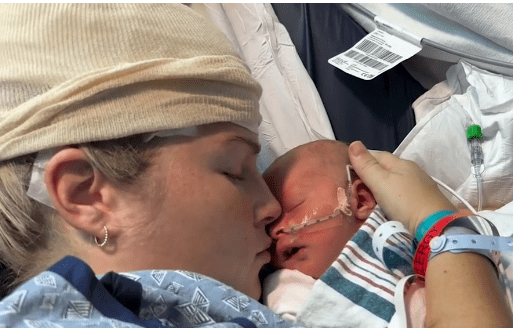Over the past few weeks, Erin Paine’s journey has been physically demanding, emotionally upsetting, and incredibly inspirational. Erin, who is well-known on Bringing Up Bates for her grounded demeanor, just gave birth to Henry, her seventh child. However, what ought to have been a happy transition swiftly devolved into a terrifying struggle with difficulties and septic shock, leaving her family to cling to hope and updates.

Chad Paine has been narrating and serving as a husband in recent days, giving candid thoughts from prayerful evenings and hospital hallways. Erin was brought to the intensive care unit (ICU) after suffering a prolonged and severe seizure due to a severe UTI and kidney infection that quickly worsened into a full-blown septic crisis. Chad characterized the situation as heartbreakingly powerless. According to him, it was one of the most difficult things he had ever had to go through to see someone he loved struggle for awareness while medical personnel rushed to stabilize her condition.
Erin Paine – Personal, Family, and Medical Information
| Category | Information |
|---|---|
| Full Name | Erin Elise Paine (née Bates) |
| Date of Birth | May 2, 1991 |
| Age | 34 |
| Spouse | Chad Paine |
| Children | Carson (10), Brooklyn (8), Everly (7), Holland (5), Finley (3), William (1), Henry (newborn) |
| Occupation | Reality TV Personality, Mother, Home Educator |
| Notable Show | “Bringing Up Bates” |
| Recent Health Crisis | Septic shock, seizure, leg paralysis following birth of seventh child |
| Current Condition | Recovering, able to walk again after weeks of paralysis |
| Source Link |
Erin’s health was controlled, albeit unclearly, through close collaboration with a skilled medical team. The diagnosis kept changing, according to her parents, Gil and Kelly Jo Bates. Just when one problem started to go away, another would appear out of nowhere. For the doctors, the family, and the hundreds of supporters who wished to contribute more than hopeful prayers, the lack of a single, definitive medical diagnosis made the journey particularly frustrating.
Erin was eventually released from the hospital after almost three weeks. Chad’s September 13 update was cautious but incredibly appreciative. Erin’s right leg was still immobile as a result of the previous seizure. But her spirit was unwavering. With genuine conviction, Chad added, “We are choosing to count every blessing.” Notwithstanding the physical challenge, the excitement of seeing their kids again overshadowed the unknowns. They got there because of their emotional and spiritual faith.
By means of tactical updates, the Paines maintained a close connection between Erin’s continued recuperation and their online community. Raw photographs, emotional captions, and heartfelt gratitude to those who had been praying for them made each letter feel incredibly personal. Because of the family’s transparency, postpartum health risks—which are frequently overlooked in conventional depictions of motherhood—were more understood.
It was clear by the end of September that recovery would not be a straight line. Even though they were back home, Chad realized that the voyage was far from finished. The doctors were unable to explain Erin’s continued inability to walk. Given that she had previously delivered babies quickly, the condition was very upsetting. While acknowledging the frustration of not knowing the answer, Chad stated, “They are hopeful on recovery.” The tone of that statement was remarkably straightforward, and it depicted a scenario that many families dealing with enigmatic postpartum issues share.
Erin then provided an update on October 2 that seemed to be a collective breath. She wrote, “Today I took steps.” For the first time since the seizure, her right leg moved. She wrote about the occasion with weeping excitement in a piece full of emotional depth and shaky accomplishment. She admitted, “I’ve cried until I laughed and laughed until I cried.” Weeks before, Erin, who was renowned on TV for her maternal and serene manner, had just stepped over a seemingly insurmountable hurdle.
Her post was profoundly introspective rather than just joyous. She expressed her gratitude to the thousands of people who had supported her both physically and spiritually, in addition to the medical team and therapists. She told them, “You have contributed to this miracle.” This group appreciation highlighted a deeply human aspect of healing: how mutual support and faith may play a critical role. The statements had the emotional weight of someone who had experienced a situation where every breath used to feel uncertain, so they weren’t empty.
Erin’s experience is similar to others who have courageously shared their hardship in the public eye when it comes to celebrity narratives. The public’s perception of what recovery actually entails has been altered by celebrities like Ashley Graham, who spoke out about postpartum healing and birth injuries, and Selma Blair, who confronted MS head-on with radical transparency. With her devotional life and Southern heritage, Erin brought a particularly grounded perspective to this changing cultural dialogue.
Erin’s argument is especially strong because it touches on issues of faith and family. Her openness has been so refreshing in a time when prominent personalities frequently construct flawless photos of ideal parenting. Her updates and remarks were always sincere, real, and occasionally shaky—never well-crafted PR pronouncements.
Erin’s perseverance is demonstrated by her choice to keep homeschooling her kids in the midst of this tempest. Her Instagram posts reflect her belief that, even when she momentarily withdraws from some of her physical responsibilities, she is nonetheless emotionally and spiritually present. It is evidence of maternal strength, where love for one’s family gives one the desire to battle even when one feels helpless.
The Paines will probably keep sharing their victories, failures, and quiet moments of grace over the next few weeks. For many other women who are silently navigating their own recovery stories, Erin’s updates, which are so richly infused with gratitude and unadulterated drive, act as a beacon of hope. Every action she does, no matter how minor, turns into an especially helpful representation of what rehabilitation actually means.
